HFR603 Hotel Finance: British Airways Investing Potential Analysis
VerifiedAdded on 2023/06/09
|24
|5092
|348
Case Study
AI Summary
This case study provides a financial analysis of British Airways, examining its investment potential over three years (2015-2017). It employs ratio analysis, including profitability, efficiency, liquidity, and capital structure ratios, to assess the company's financial health. Key ratios like return on assets, return on equity, profit margin, inventory turnover, current ratio, and debt-to-equity ratio are calculated and interpreted. The analysis identifies trends and discusses areas of financial risk, capital structure, and profitability. The report concludes with an evaluation of British Airways' financial standing and investment attractiveness. Desklib offers a range of solved assignments and past papers for students.
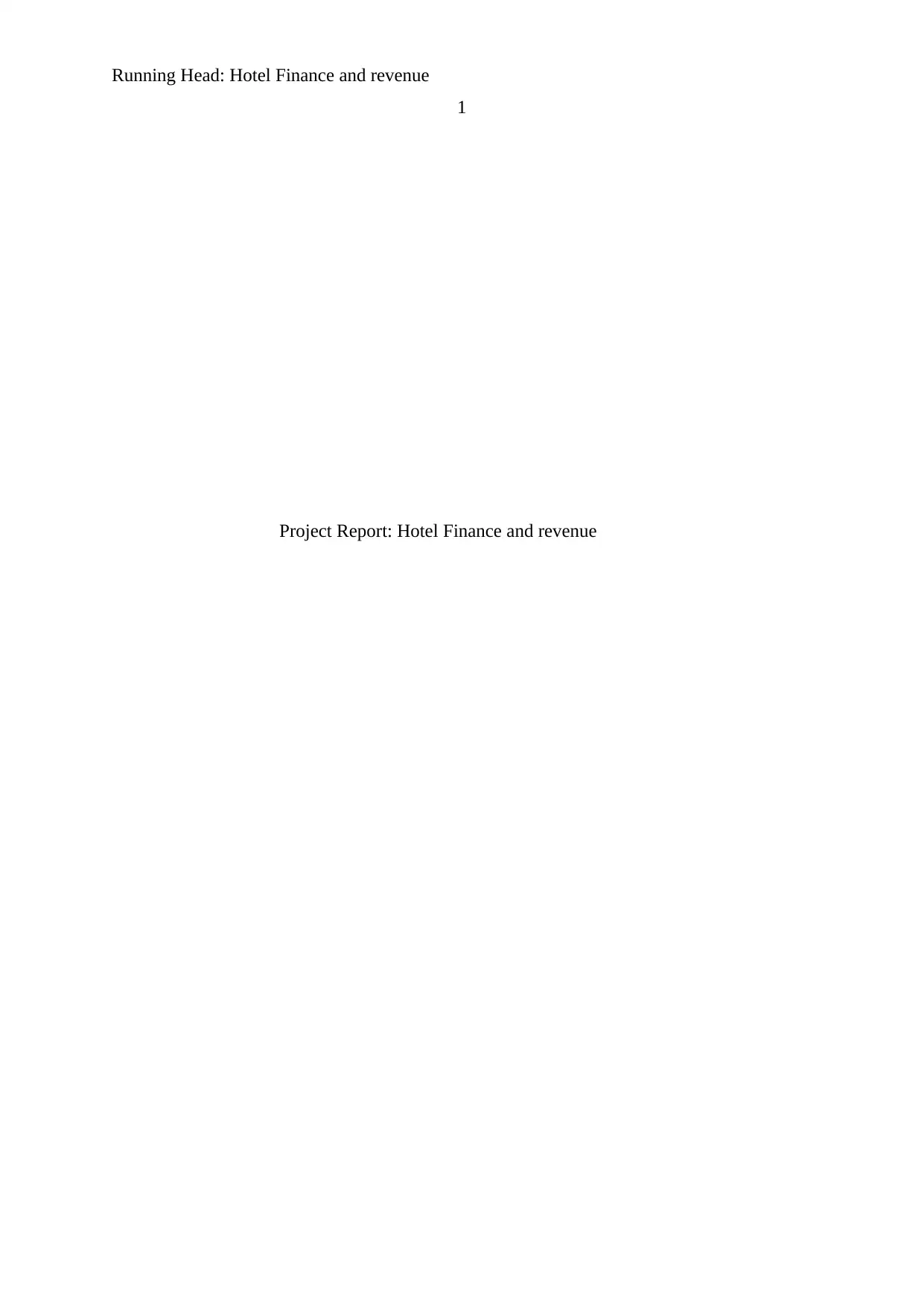
Running Head: Hotel Finance and revenue
1
Project Report: Hotel Finance and revenue
1
Project Report: Hotel Finance and revenue
Paraphrase This Document
Need a fresh take? Get an instant paraphrase of this document with our AI Paraphraser
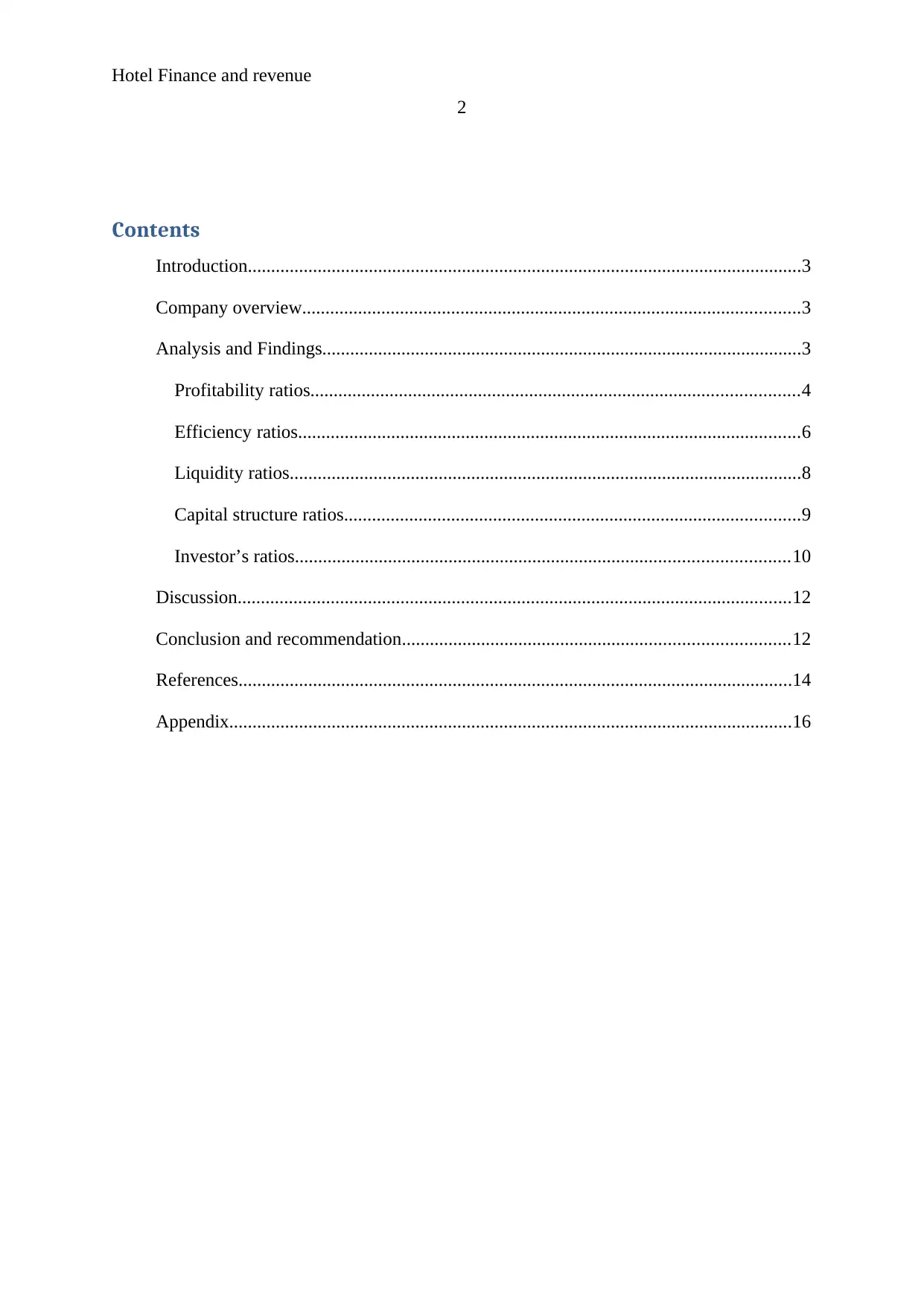
Hotel Finance and revenue
2
Contents
Introduction.......................................................................................................................3
Company overview...........................................................................................................3
Analysis and Findings.......................................................................................................3
Profitability ratios.........................................................................................................4
Efficiency ratios............................................................................................................6
Liquidity ratios..............................................................................................................8
Capital structure ratios..................................................................................................9
Investor’s ratios..........................................................................................................10
Discussion.......................................................................................................................12
Conclusion and recommendation...................................................................................12
References.......................................................................................................................14
Appendix.........................................................................................................................16
2
Contents
Introduction.......................................................................................................................3
Company overview...........................................................................................................3
Analysis and Findings.......................................................................................................3
Profitability ratios.........................................................................................................4
Efficiency ratios............................................................................................................6
Liquidity ratios..............................................................................................................8
Capital structure ratios..................................................................................................9
Investor’s ratios..........................................................................................................10
Discussion.......................................................................................................................12
Conclusion and recommendation...................................................................................12
References.......................................................................................................................14
Appendix.........................................................................................................................16
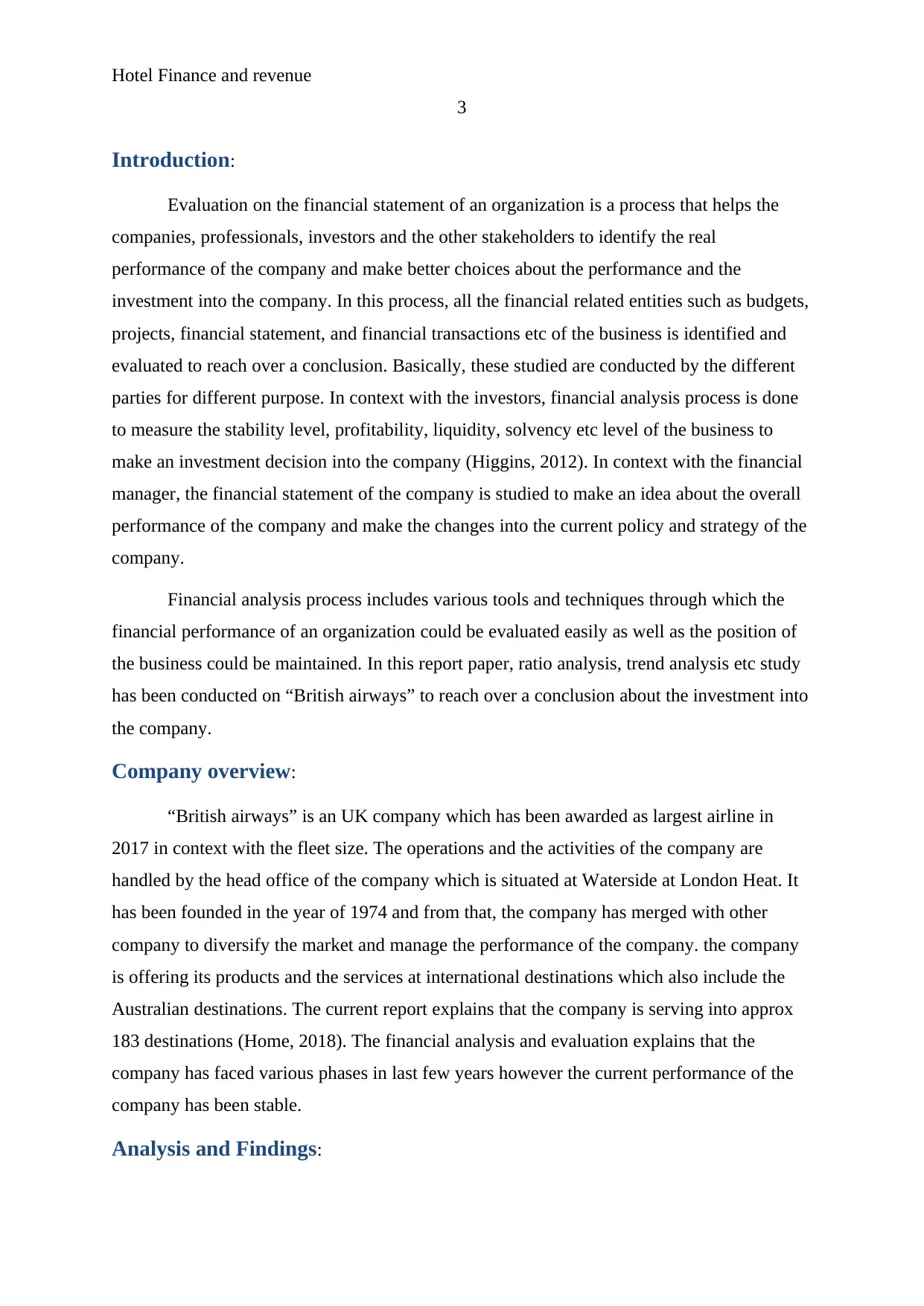
Hotel Finance and revenue
3
Introduction:
Evaluation on the financial statement of an organization is a process that helps the
companies, professionals, investors and the other stakeholders to identify the real
performance of the company and make better choices about the performance and the
investment into the company. In this process, all the financial related entities such as budgets,
projects, financial statement, and financial transactions etc of the business is identified and
evaluated to reach over a conclusion. Basically, these studied are conducted by the different
parties for different purpose. In context with the investors, financial analysis process is done
to measure the stability level, profitability, liquidity, solvency etc level of the business to
make an investment decision into the company (Higgins, 2012). In context with the financial
manager, the financial statement of the company is studied to make an idea about the overall
performance of the company and make the changes into the current policy and strategy of the
company.
Financial analysis process includes various tools and techniques through which the
financial performance of an organization could be evaluated easily as well as the position of
the business could be maintained. In this report paper, ratio analysis, trend analysis etc study
has been conducted on “British airways” to reach over a conclusion about the investment into
the company.
Company overview:
“British airways” is an UK company which has been awarded as largest airline in
2017 in context with the fleet size. The operations and the activities of the company are
handled by the head office of the company which is situated at Waterside at London Heat. It
has been founded in the year of 1974 and from that, the company has merged with other
company to diversify the market and manage the performance of the company. the company
is offering its products and the services at international destinations which also include the
Australian destinations. The current report explains that the company is serving into approx
183 destinations (Home, 2018). The financial analysis and evaluation explains that the
company has faced various phases in last few years however the current performance of the
company has been stable.
Analysis and Findings:
3
Introduction:
Evaluation on the financial statement of an organization is a process that helps the
companies, professionals, investors and the other stakeholders to identify the real
performance of the company and make better choices about the performance and the
investment into the company. In this process, all the financial related entities such as budgets,
projects, financial statement, and financial transactions etc of the business is identified and
evaluated to reach over a conclusion. Basically, these studied are conducted by the different
parties for different purpose. In context with the investors, financial analysis process is done
to measure the stability level, profitability, liquidity, solvency etc level of the business to
make an investment decision into the company (Higgins, 2012). In context with the financial
manager, the financial statement of the company is studied to make an idea about the overall
performance of the company and make the changes into the current policy and strategy of the
company.
Financial analysis process includes various tools and techniques through which the
financial performance of an organization could be evaluated easily as well as the position of
the business could be maintained. In this report paper, ratio analysis, trend analysis etc study
has been conducted on “British airways” to reach over a conclusion about the investment into
the company.
Company overview:
“British airways” is an UK company which has been awarded as largest airline in
2017 in context with the fleet size. The operations and the activities of the company are
handled by the head office of the company which is situated at Waterside at London Heat. It
has been founded in the year of 1974 and from that, the company has merged with other
company to diversify the market and manage the performance of the company. the company
is offering its products and the services at international destinations which also include the
Australian destinations. The current report explains that the company is serving into approx
183 destinations (Home, 2018). The financial analysis and evaluation explains that the
company has faced various phases in last few years however the current performance of the
company has been stable.
Analysis and Findings:
⊘ This is a preview!⊘
Do you want full access?
Subscribe today to unlock all pages.

Trusted by 1+ million students worldwide

Hotel Finance and revenue
4
The financial evaluation study has been done on the financial statement of “British
airways” to measure the financial performance and the financial changes of the company. the
study of ratio analysis has been done on the company initially to evaluate the stability,
profitability, liquidity, solvency etc level of the business to make an investment decision into
the company. In addition, this study has also been performed to measure the changes into the
financial performance of the company in last 3 years.
The study of ratio analysis is a technical and quantitative analysis that measures the
information and the idea about the financial performance, changes and the position of the
company (Gapenski & Reiter, 2008). This study is used by the investors as well as by the
companies to evaluates and measure the numerous aspect related to the financial performance
of the company. It further explains that how the company is performing in context with the
stability, profitability, liquidity, solvency level. The ratio analysis of British airways is as
follows:
Profitability ratios:
Profitability ratios are one of the crucial tools to measure the profit generation level of
the business. It measures the net profit, gross profit and operating profit of the business
through different financial term to measure the profit generation capabilities of the business.
the profitability ratios make it easier for the analyst and the investors of the organization to
measure the profit generation level of the business. Profitability ratios include various ratios
to identity the profitability performance of the company. the profitability ratios of the
company are as follows:
Return on assets:
Return on assets (ROA) is a profitability ratio which measures the net profit of the
business on the basis of the total resources of the business at a particular time period (Fridson
& Alvarez, 2011). The ROA profitability level of British airways has been given in the below
table which explains about improved return on assets from 2015 in 2017. The current ROA
level of the business is 8.88% which is quite competitive.
Return on
assets
Net profit / 51,76,000 48,95,000 81,97,000
Total assets 9,44,08
,000
8,99,97
,000
9,23,33,
000
Answer: % 5.48% 5.44% 8.88%
4
The financial evaluation study has been done on the financial statement of “British
airways” to measure the financial performance and the financial changes of the company. the
study of ratio analysis has been done on the company initially to evaluate the stability,
profitability, liquidity, solvency etc level of the business to make an investment decision into
the company. In addition, this study has also been performed to measure the changes into the
financial performance of the company in last 3 years.
The study of ratio analysis is a technical and quantitative analysis that measures the
information and the idea about the financial performance, changes and the position of the
company (Gapenski & Reiter, 2008). This study is used by the investors as well as by the
companies to evaluates and measure the numerous aspect related to the financial performance
of the company. It further explains that how the company is performing in context with the
stability, profitability, liquidity, solvency level. The ratio analysis of British airways is as
follows:
Profitability ratios:
Profitability ratios are one of the crucial tools to measure the profit generation level of
the business. It measures the net profit, gross profit and operating profit of the business
through different financial term to measure the profit generation capabilities of the business.
the profitability ratios make it easier for the analyst and the investors of the organization to
measure the profit generation level of the business. Profitability ratios include various ratios
to identity the profitability performance of the company. the profitability ratios of the
company are as follows:
Return on assets:
Return on assets (ROA) is a profitability ratio which measures the net profit of the
business on the basis of the total resources of the business at a particular time period (Fridson
& Alvarez, 2011). The ROA profitability level of British airways has been given in the below
table which explains about improved return on assets from 2015 in 2017. The current ROA
level of the business is 8.88% which is quite competitive.
Return on
assets
Net profit / 51,76,000 48,95,000 81,97,000
Total assets 9,44,08
,000
8,99,97
,000
9,23,33,
000
Answer: % 5.48% 5.44% 8.88%
Paraphrase This Document
Need a fresh take? Get an instant paraphrase of this document with our AI Paraphraser
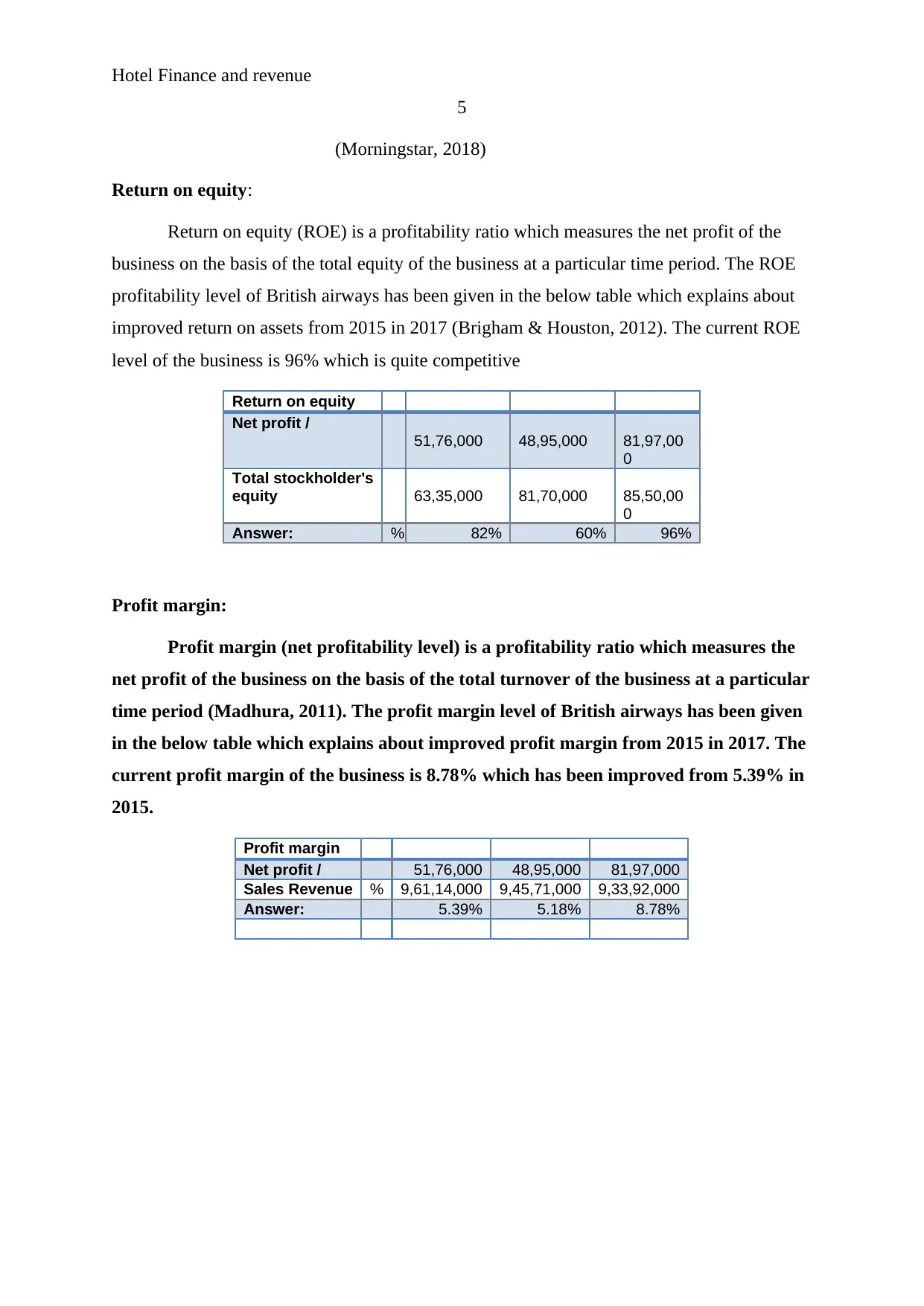
Hotel Finance and revenue
5
(Morningstar, 2018)
Return on equity:
Return on equity (ROE) is a profitability ratio which measures the net profit of the
business on the basis of the total equity of the business at a particular time period. The ROE
profitability level of British airways has been given in the below table which explains about
improved return on assets from 2015 in 2017 (Brigham & Houston, 2012). The current ROE
level of the business is 96% which is quite competitive
Return on equity
Net profit /
51,76,000 48,95,000 81,97,00
0
Total stockholder's
equity 63,35,000 81,70,000 85,50,00
0
Answer: % 82% 60% 96%
Profit margin:
Profit margin (net profitability level) is a profitability ratio which measures the
net profit of the business on the basis of the total turnover of the business at a particular
time period (Madhura, 2011). The profit margin level of British airways has been given
in the below table which explains about improved profit margin from 2015 in 2017. The
current profit margin of the business is 8.78% which has been improved from 5.39% in
2015.
Profit margin
Net profit / 51,76,000 48,95,000 81,97,000
Sales Revenue % 9,61,14,000 9,45,71,000 9,33,92,000
Answer: 5.39% 5.18% 8.78%
5
(Morningstar, 2018)
Return on equity:
Return on equity (ROE) is a profitability ratio which measures the net profit of the
business on the basis of the total equity of the business at a particular time period. The ROE
profitability level of British airways has been given in the below table which explains about
improved return on assets from 2015 in 2017 (Brigham & Houston, 2012). The current ROE
level of the business is 96% which is quite competitive
Return on equity
Net profit /
51,76,000 48,95,000 81,97,00
0
Total stockholder's
equity 63,35,000 81,70,000 85,50,00
0
Answer: % 82% 60% 96%
Profit margin:
Profit margin (net profitability level) is a profitability ratio which measures the
net profit of the business on the basis of the total turnover of the business at a particular
time period (Madhura, 2011). The profit margin level of British airways has been given
in the below table which explains about improved profit margin from 2015 in 2017. The
current profit margin of the business is 8.78% which has been improved from 5.39% in
2015.
Profit margin
Net profit / 51,76,000 48,95,000 81,97,000
Sales Revenue % 9,61,14,000 9,45,71,000 9,33,92,000
Answer: 5.39% 5.18% 8.78%
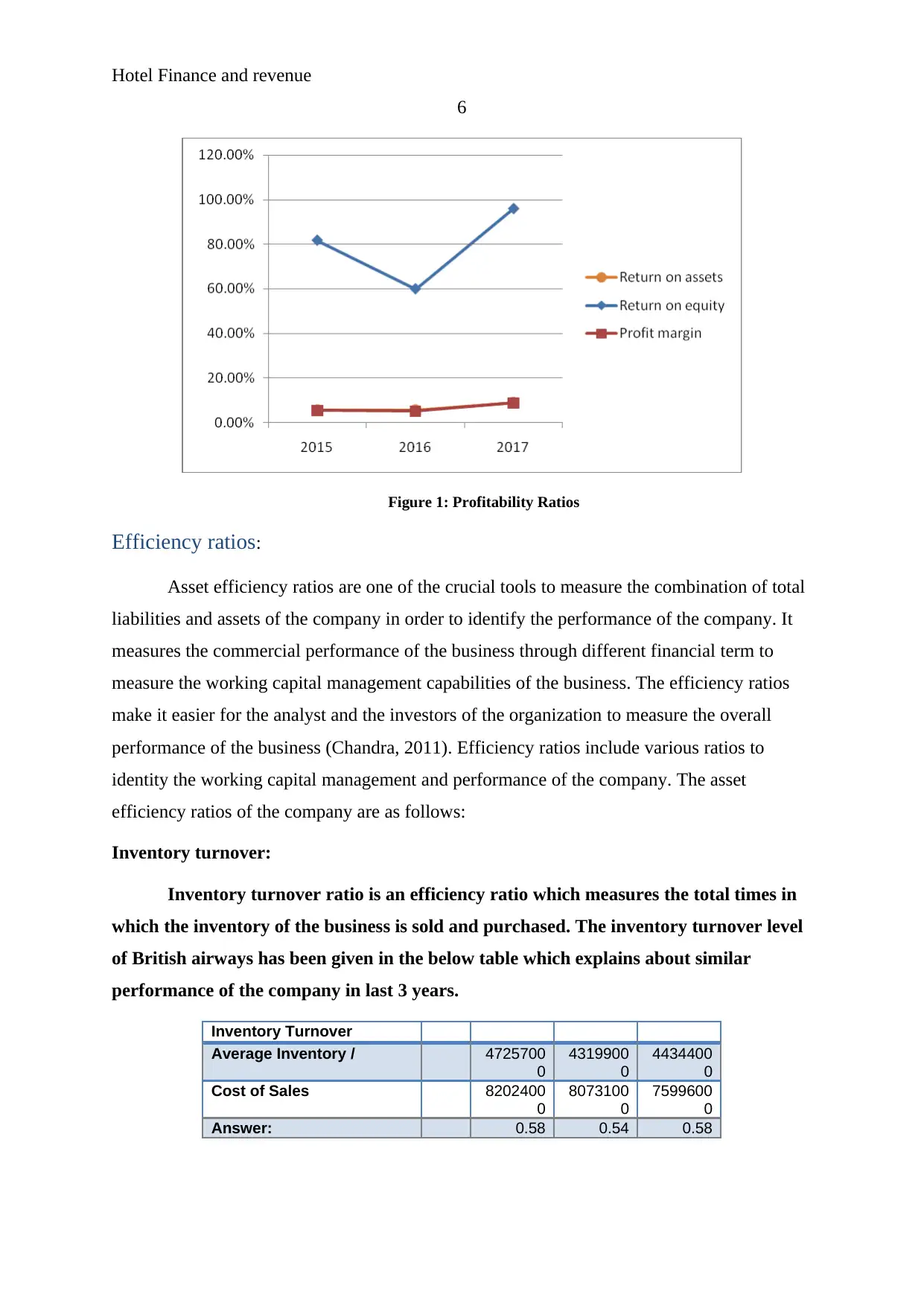
Hotel Finance and revenue
6
Figure 1: Profitability Ratios
Efficiency ratios:
Asset efficiency ratios are one of the crucial tools to measure the combination of total
liabilities and assets of the company in order to identify the performance of the company. It
measures the commercial performance of the business through different financial term to
measure the working capital management capabilities of the business. The efficiency ratios
make it easier for the analyst and the investors of the organization to measure the overall
performance of the business (Chandra, 2011). Efficiency ratios include various ratios to
identity the working capital management and performance of the company. The asset
efficiency ratios of the company are as follows:
Inventory turnover:
Inventory turnover ratio is an efficiency ratio which measures the total times in
which the inventory of the business is sold and purchased. The inventory turnover level
of British airways has been given in the below table which explains about similar
performance of the company in last 3 years.
Inventory Turnover
Average Inventory / 4725700
0
4319900
0
4434400
0
Cost of Sales 8202400
0
8073100
0
7599600
0
Answer: 0.58 0.54 0.58
6
Figure 1: Profitability Ratios
Efficiency ratios:
Asset efficiency ratios are one of the crucial tools to measure the combination of total
liabilities and assets of the company in order to identify the performance of the company. It
measures the commercial performance of the business through different financial term to
measure the working capital management capabilities of the business. The efficiency ratios
make it easier for the analyst and the investors of the organization to measure the overall
performance of the business (Chandra, 2011). Efficiency ratios include various ratios to
identity the working capital management and performance of the company. The asset
efficiency ratios of the company are as follows:
Inventory turnover:
Inventory turnover ratio is an efficiency ratio which measures the total times in
which the inventory of the business is sold and purchased. The inventory turnover level
of British airways has been given in the below table which explains about similar
performance of the company in last 3 years.
Inventory Turnover
Average Inventory / 4725700
0
4319900
0
4434400
0
Cost of Sales 8202400
0
8073100
0
7599600
0
Answer: 0.58 0.54 0.58
⊘ This is a preview!⊘
Do you want full access?
Subscribe today to unlock all pages.

Trusted by 1+ million students worldwide

Hotel Finance and revenue
7
Inventory turnover (days):
Inventory turnover days are an efficiency ratio which measures the total time
period in which the inventory of the business would be turned. The inventory turnover
level (days) of British airways has been given in the below table which explains about
similar performance of the company in last 3 years
Inventory Turnover (days)
Average Inventory / 4,72,57,
000
4,31,99,
000
4,43,44,
000
Cost of Sales #
days
8,20,24,
000
8,07,31,
000
7,59,96,
000
Answer: (note the above needs to
be x 365)
210.29 195.31 212.98
Accounts receivable turnover:
Accounts receivable ratio is an efficiency ratio which measures the total time in
which the debtor’s amount would be received and new debtor’s amount would take
place (Rose & Hudgins, 2012). The accounts receivable turnover level of British airways
has been given in the below table which explains about improved level of the company
in last 3 years. It explains that more working capital is required by the business now.
Accounts receivable
turnover
Average trade debtors / 8003000 7804000 9763000
Sales revenue 9,61,14,00
0
9,45,71,00
0
9,33,92,00
0
Answer: 0.083 0.083 0.105
Accounts receivable turnover (days):
Accounts receivable turnover days ratio is an efficiency ratio which measures the total
time period in which the debtor’s amount would be received and new debtor’s amount would
take place. The accounts receivable turnover days level of British airways has been given in
the below table which explains about improved level of the company in last 3 years. It
explains that more working capital is required by the business now.
Receivables Turnover
(days)
Average trade debtors / 80, 78, 97,6
7
Inventory turnover (days):
Inventory turnover days are an efficiency ratio which measures the total time
period in which the inventory of the business would be turned. The inventory turnover
level (days) of British airways has been given in the below table which explains about
similar performance of the company in last 3 years
Inventory Turnover (days)
Average Inventory / 4,72,57,
000
4,31,99,
000
4,43,44,
000
Cost of Sales #
days
8,20,24,
000
8,07,31,
000
7,59,96,
000
Answer: (note the above needs to
be x 365)
210.29 195.31 212.98
Accounts receivable turnover:
Accounts receivable ratio is an efficiency ratio which measures the total time in
which the debtor’s amount would be received and new debtor’s amount would take
place (Rose & Hudgins, 2012). The accounts receivable turnover level of British airways
has been given in the below table which explains about improved level of the company
in last 3 years. It explains that more working capital is required by the business now.
Accounts receivable
turnover
Average trade debtors / 8003000 7804000 9763000
Sales revenue 9,61,14,00
0
9,45,71,00
0
9,33,92,00
0
Answer: 0.083 0.083 0.105
Accounts receivable turnover (days):
Accounts receivable turnover days ratio is an efficiency ratio which measures the total
time period in which the debtor’s amount would be received and new debtor’s amount would
take place. The accounts receivable turnover days level of British airways has been given in
the below table which explains about improved level of the company in last 3 years. It
explains that more working capital is required by the business now.
Receivables Turnover
(days)
Average trade debtors / 80, 78, 97,6
Paraphrase This Document
Need a fresh take? Get an instant paraphrase of this document with our AI Paraphraser
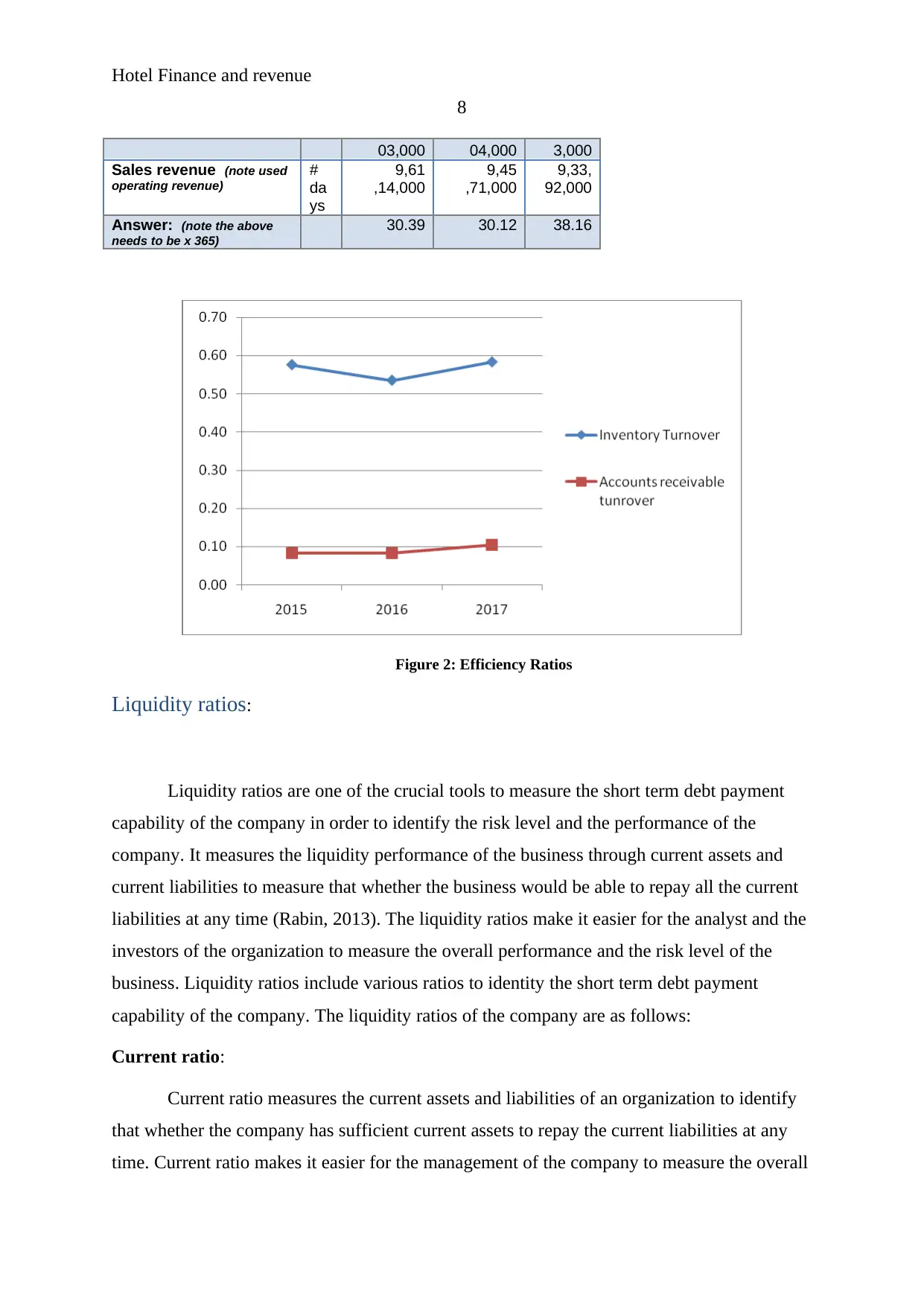
Hotel Finance and revenue
8
03,000 04,000 3,000
Sales revenue (note used
operating revenue)
#
da
ys
9,61
,14,000
9,45
,71,000
9,33,
92,000
Answer: (note the above
needs to be x 365)
30.39 30.12 38.16
Figure 2: Efficiency Ratios
Liquidity ratios:
Liquidity ratios are one of the crucial tools to measure the short term debt payment
capability of the company in order to identify the risk level and the performance of the
company. It measures the liquidity performance of the business through current assets and
current liabilities to measure that whether the business would be able to repay all the current
liabilities at any time (Rabin, 2013). The liquidity ratios make it easier for the analyst and the
investors of the organization to measure the overall performance and the risk level of the
business. Liquidity ratios include various ratios to identity the short term debt payment
capability of the company. The liquidity ratios of the company are as follows:
Current ratio:
Current ratio measures the current assets and liabilities of an organization to identify
that whether the company has sufficient current assets to repay the current liabilities at any
time. Current ratio makes it easier for the management of the company to measure the overall
8
03,000 04,000 3,000
Sales revenue (note used
operating revenue)
#
da
ys
9,61
,14,000
9,45
,71,000
9,33,
92,000
Answer: (note the above
needs to be x 365)
30.39 30.12 38.16
Figure 2: Efficiency Ratios
Liquidity ratios:
Liquidity ratios are one of the crucial tools to measure the short term debt payment
capability of the company in order to identify the risk level and the performance of the
company. It measures the liquidity performance of the business through current assets and
current liabilities to measure that whether the business would be able to repay all the current
liabilities at any time (Rabin, 2013). The liquidity ratios make it easier for the analyst and the
investors of the organization to measure the overall performance and the risk level of the
business. Liquidity ratios include various ratios to identity the short term debt payment
capability of the company. The liquidity ratios of the company are as follows:
Current ratio:
Current ratio measures the current assets and liabilities of an organization to identify
that whether the company has sufficient current assets to repay the current liabilities at any
time. Current ratio makes it easier for the management of the company to measure the overall

Hotel Finance and revenue
9
performance of the company. the current ratio of the company explains about lowered
performance in current year. However, the company could repay the amount easily to the
creditors of the company.
Current Ratio
Current Assets / 6,82,34,00
0
6,24,88,00
0
6,51,61,00
0
Current liabilities 5,04,12,00
0
5,01,34,00
0
5,62,69,00
0
Answer: 1.35 1.25 1.16
Quick ratio:
Quick ratio measures the quick assets and liabilities of an organization to identify that
whether the company has sufficient quick assets to repay the current liabilities at any time.
The quick ratio of the company explains about lowered performance in current year (Porcelli
& Delgado, 2009). It explains that the risk level of the company is higher and company is
required to improve the level of the assets to manage the performance.
Quick ratio
Current Assets -
Inventory /
2,09,77,00
0
1,92,89,00
0
2,08,17,00
0
Current Liabilities 5,04,12,00
0
5,01,34,00
0
5,62,69,00
0
Answer: 0.42 0.38 0.37
Figure 3: Liquidity ratio
9
performance of the company. the current ratio of the company explains about lowered
performance in current year. However, the company could repay the amount easily to the
creditors of the company.
Current Ratio
Current Assets / 6,82,34,00
0
6,24,88,00
0
6,51,61,00
0
Current liabilities 5,04,12,00
0
5,01,34,00
0
5,62,69,00
0
Answer: 1.35 1.25 1.16
Quick ratio:
Quick ratio measures the quick assets and liabilities of an organization to identify that
whether the company has sufficient quick assets to repay the current liabilities at any time.
The quick ratio of the company explains about lowered performance in current year (Porcelli
& Delgado, 2009). It explains that the risk level of the company is higher and company is
required to improve the level of the assets to manage the performance.
Quick ratio
Current Assets -
Inventory /
2,09,77,00
0
1,92,89,00
0
2,08,17,00
0
Current Liabilities 5,04,12,00
0
5,01,34,00
0
5,62,69,00
0
Answer: 0.42 0.38 0.37
Figure 3: Liquidity ratio
⊘ This is a preview!⊘
Do you want full access?
Subscribe today to unlock all pages.

Trusted by 1+ million students worldwide

Hotel Finance and revenue
10
(Morningstar, 2018)
Capital structure ratios:
Capital structure ratios are one of the crucial tools to measure the capital performance
and asset, liability and equity level of the business (Mandell & Hanson, 2009). It measures
the cost and risk performance of the business through identifying the changes into the capital
structure of the business. The capital structure ratios of British airways are as follows:
Debt to asset ratio:
Debt to asset ratio of British airways explains that the debt level of the business
has been improved in context with the assets level. It explains that the leveraged
position of the company has been better.
Debt to assets
ratio
Total debt / 98,14,000 98,14,000 1,03,79,0
00
total assets 9,44,08,000 8,99,97,000 9,23,33,0
00
Answer: %
0.104 0.109 0.112
Debt to equity ratio:
Further, debt to equity ratio of British airways explains that the debt level of the
business has been lowered in context with the equity level. It explains that the risk level and
cost level must be evaluated again by the company.
Debt to equity
ratio
Total debt / 98,14,000 98,14,000 1,03,79,0
00
Total equity 63,35,000 81,70,000 85,50,000
Answer: % 1
.549
1
.201
1.
214
10
(Morningstar, 2018)
Capital structure ratios:
Capital structure ratios are one of the crucial tools to measure the capital performance
and asset, liability and equity level of the business (Mandell & Hanson, 2009). It measures
the cost and risk performance of the business through identifying the changes into the capital
structure of the business. The capital structure ratios of British airways are as follows:
Debt to asset ratio:
Debt to asset ratio of British airways explains that the debt level of the business
has been improved in context with the assets level. It explains that the leveraged
position of the company has been better.
Debt to assets
ratio
Total debt / 98,14,000 98,14,000 1,03,79,0
00
total assets 9,44,08,000 8,99,97,000 9,23,33,0
00
Answer: %
0.104 0.109 0.112
Debt to equity ratio:
Further, debt to equity ratio of British airways explains that the debt level of the
business has been lowered in context with the equity level. It explains that the risk level and
cost level must be evaluated again by the company.
Debt to equity
ratio
Total debt / 98,14,000 98,14,000 1,03,79,0
00
Total equity 63,35,000 81,70,000 85,50,000
Answer: % 1
.549
1
.201
1.
214
Paraphrase This Document
Need a fresh take? Get an instant paraphrase of this document with our AI Paraphraser
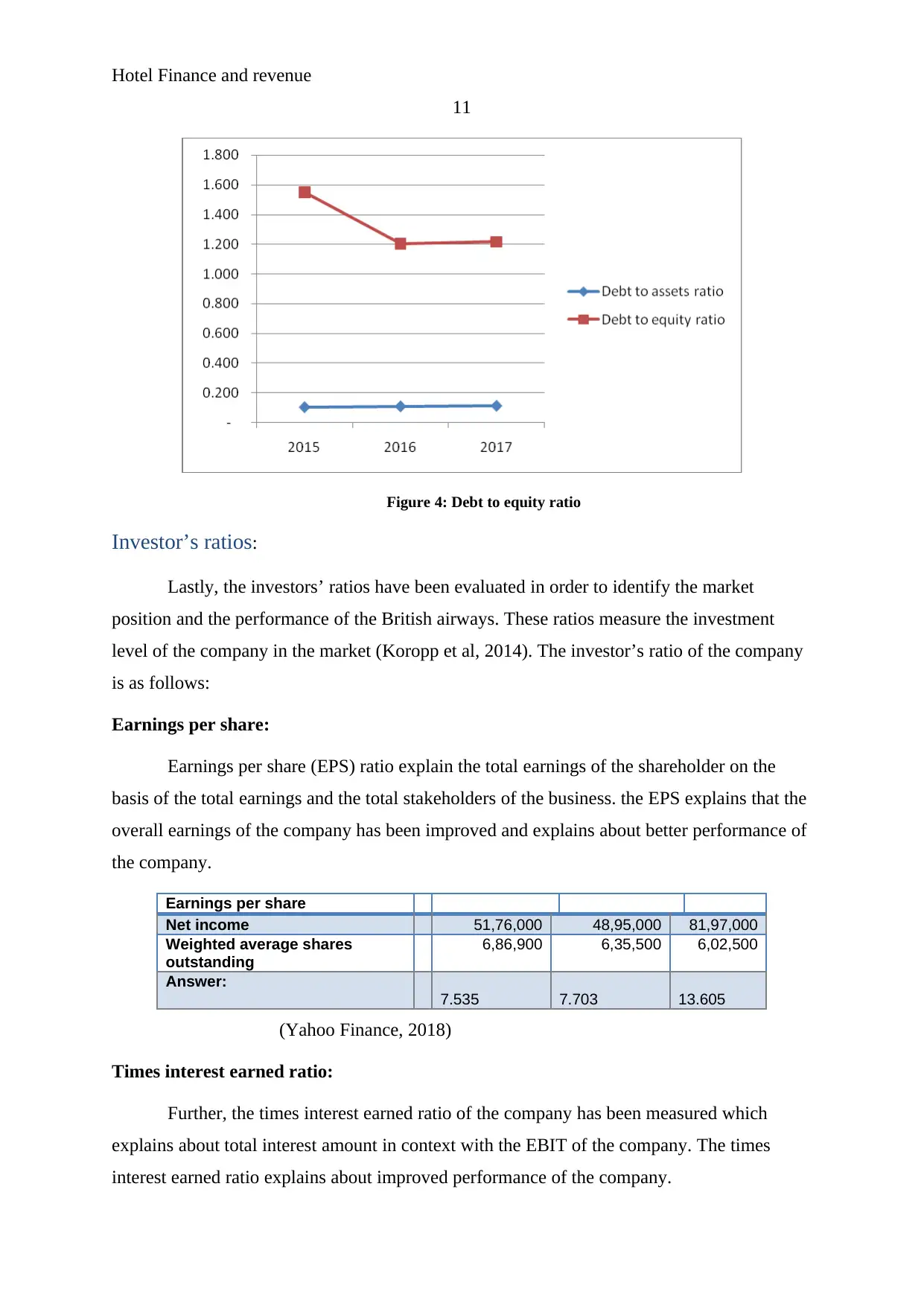
Hotel Finance and revenue
11
Figure 4: Debt to equity ratio
Investor’s ratios:
Lastly, the investors’ ratios have been evaluated in order to identify the market
position and the performance of the British airways. These ratios measure the investment
level of the company in the market (Koropp et al, 2014). The investor’s ratio of the company
is as follows:
Earnings per share:
Earnings per share (EPS) ratio explain the total earnings of the shareholder on the
basis of the total earnings and the total stakeholders of the business. the EPS explains that the
overall earnings of the company has been improved and explains about better performance of
the company.
Earnings per share
Net income 51,76,000 48,95,000 81,97,000
Weighted average shares
outstanding
6,86,900 6,35,500 6,02,500
Answer:
7.535 7.703 13.605
(Yahoo Finance, 2018)
Times interest earned ratio:
Further, the times interest earned ratio of the company has been measured which
explains about total interest amount in context with the EBIT of the company. The times
interest earned ratio explains about improved performance of the company.
11
Figure 4: Debt to equity ratio
Investor’s ratios:
Lastly, the investors’ ratios have been evaluated in order to identify the market
position and the performance of the British airways. These ratios measure the investment
level of the company in the market (Koropp et al, 2014). The investor’s ratio of the company
is as follows:
Earnings per share:
Earnings per share (EPS) ratio explain the total earnings of the shareholder on the
basis of the total earnings and the total stakeholders of the business. the EPS explains that the
overall earnings of the company has been improved and explains about better performance of
the company.
Earnings per share
Net income 51,76,000 48,95,000 81,97,000
Weighted average shares
outstanding
6,86,900 6,35,500 6,02,500
Answer:
7.535 7.703 13.605
(Yahoo Finance, 2018)
Times interest earned ratio:
Further, the times interest earned ratio of the company has been measured which
explains about total interest amount in context with the EBIT of the company. The times
interest earned ratio explains about improved performance of the company.

Hotel Finance and revenue
12
Times interest
earned ratio
EBIT / 72,34,000 55,97,000 1,01,23,0
00
Interest payable 3,39,000 3,65,000 4,30,000
Answer: 2
1.339
1
5.334
23
.542
Figure 5: Investor's ratios
Discussion:
The above calculations and the analysis on the British airways explain that the
company has faced various phases in last 3 years. Various levels of the business have been
measured of last 3 years to identify the overall performance of the company. Firstly, the
profitability position of the company has been studied and it has been found that the overall
profit generation capabilities of the company have been improved. However, it has also been
estimated that the operating expenses of the company are quite higher and due to which the
net profits of the company are lower (DemaMoreno, 2009). If the organization would control
on these expenses than the overall performance of the business would be better in terms of
profitability.
Further, the efficiency ratios have been evaluated and it has been found that the
overall ratios of the company explain that the high working capital is required by the
company in current year to manage the performance of the company. It explains that few
12
Times interest
earned ratio
EBIT / 72,34,000 55,97,000 1,01,23,0
00
Interest payable 3,39,000 3,65,000 4,30,000
Answer: 2
1.339
1
5.334
23
.542
Figure 5: Investor's ratios
Discussion:
The above calculations and the analysis on the British airways explain that the
company has faced various phases in last 3 years. Various levels of the business have been
measured of last 3 years to identify the overall performance of the company. Firstly, the
profitability position of the company has been studied and it has been found that the overall
profit generation capabilities of the company have been improved. However, it has also been
estimated that the operating expenses of the company are quite higher and due to which the
net profits of the company are lower (DemaMoreno, 2009). If the organization would control
on these expenses than the overall performance of the business would be better in terms of
profitability.
Further, the efficiency ratios have been evaluated and it has been found that the
overall ratios of the company explain that the high working capital is required by the
company in current year to manage the performance of the company. It explains that few
⊘ This is a preview!⊘
Do you want full access?
Subscribe today to unlock all pages.

Trusted by 1+ million students worldwide
1 out of 24
Related Documents
Your All-in-One AI-Powered Toolkit for Academic Success.
+13062052269
info@desklib.com
Available 24*7 on WhatsApp / Email
![[object Object]](/_next/static/media/star-bottom.7253800d.svg)
Unlock your academic potential
Copyright © 2020–2025 A2Z Services. All Rights Reserved. Developed and managed by ZUCOL.





